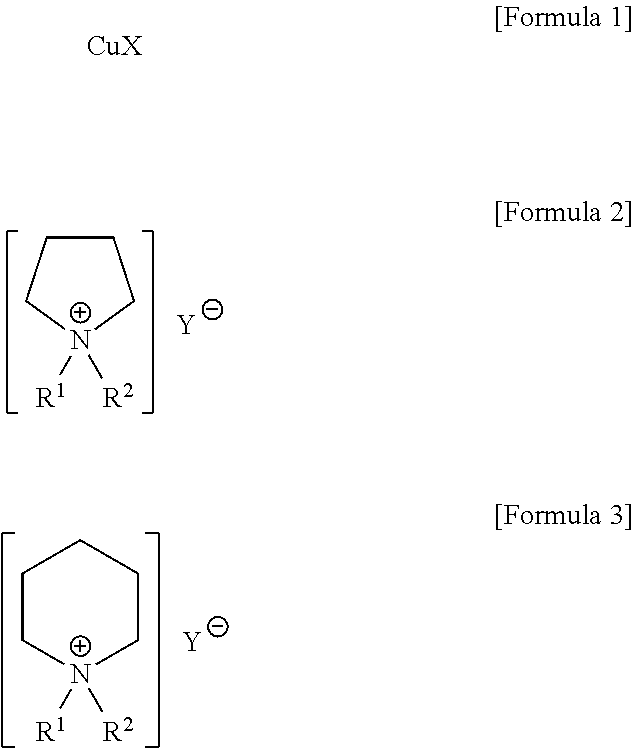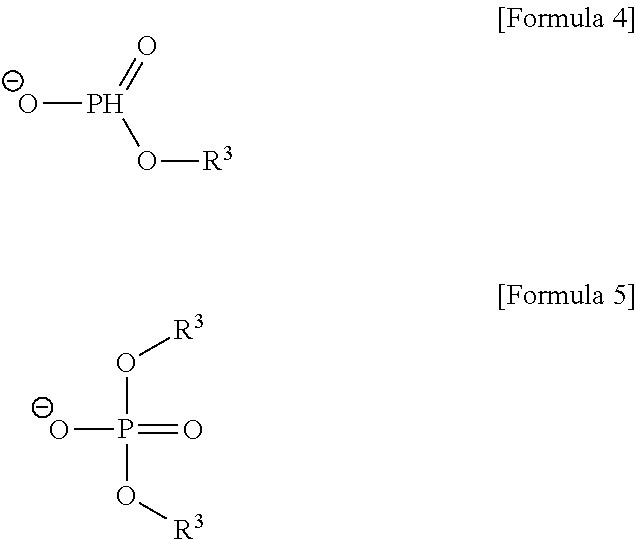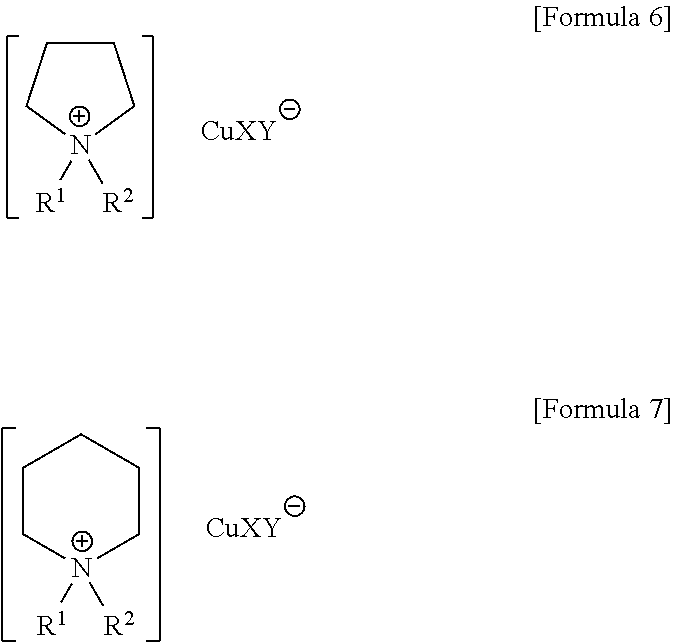Method of purifying olefins using pyrrolidinium-based or piperidinium-based ionic liquids comprising copper (I) halide
a technology of ionic liquid and olefin, which is applied in the direction of organic compound/hydride/coordination complex catalyst, physical/chemical process catalyst, other chemical processes, etc., can solve the problems of reducing the product quality of the resulting polyolefin, affecting the purification efficiency of olefin, etc., to achieve the selective removal rate of acetylenic compounds to olefin, the effect of long-term
- Summary
- Abstract
- Description
- Claims
- Application Information
AI Technical Summary
Benefits of technology
Problems solved by technology
Method used
Image
Examples
example 1
Preparation of Pyrrolidinium-based and Piperidinium-based Ionic Liquids
[0043]1-alkylpyrrolidine and 1-alkylpiperidine were reacted with dialkylphosphite or trialkylphosphate in order to prepare the pyrrolidinium-based and piperidinium-based ionic liquids used in the present invention.
Synthesis of N,N-butylethylpyrrolidinium ethylphosphite
[0044]In a 500 ml two-necked flask with a reflux condenser, 60 g of 1-butylpyrrolidine was reacted with 78 g of diethylphosphite under stirring at 80° C. for 12 hrs. After the reaction was terminated, the reactant was washed several times with ethylacetate or diethylether to remove the unreacted 1-butylpyrrolidine and diethylphosphite. The remaining ionic liquid was vacuum dried at 60° C. to obtain the title compound (yield: 98%).
[0045]A variety of dialkylpyrrolidinium alkylphosphites were synthesized in a similar manner as described above.
Synthesis of N,N-ethylmethylpyrrolidinium diethylphosphate
[0046]In a 500 ml two-necked flask with a reflux co...
example 2
[0052]2.0 g of N,N-ethylmethylpyrrolidinium ethylphosphite, synthesized by reacting N,N-ethylmethylpyrrolidine with diethylphosphite using the same procedure described in Example 1 above, was mixed with 0.4 g of CuCl to prepare a pyrrolidinium-based absorbent. In the prepared pyrrolidinium-based ionic liquid, 1 g of isoprene sample comprising 1,000 ppm of each of C5 acetylene, i.e., isopropenylacetylene (IPA) and 2-butyne (2-BT) and 5,000 ppm of n-heptane as an internal standard material was added at 25° C. and stirred for 1 min. at the same temperature. After stirring, the upper and lower layer liquids were each analyzed by using chromatography (model 6890 N, Agilent) with a HP-PLOT column and 400 MHz 1H NMR (Brucker). As a result, of the isoprene sample, 100% of isopropenylacetylene (IPA), 31% of 2-BT, and 0.05% of isoprene were detected in the lower layer liquid. The above results show that a very small amount of acetylene contained in olefin can be effectively extracted by the p...
example 3
[0053]2.0 g of N,N-ethylmethylpiperidinium ethylphosphite synthesized according to Example 1 was mixed with 0.4 g of CuCl to prepare a piperidinium-based ionic liquid. In the prepared piperidinium-based ionic liquid, 1 g of isoprene sample comprising 1,000 ppm of each of C5 acetylene, i.e., isopropenylacetylene (IPA) and 2-butyne (2-BT) and 5,000 ppm of n-heptane as an internal standard material was added at 25° C. and stirred for 1 min. at the same temperature. After stirring, the upper and lower layer liquids were each analyzed by using chromatography (model 6890 N, Agilent) with a HP-PLOT column and 400 MHz 1H NMR (Brucker). As a result, of the isoprene sample, 100% of isoprophenylacetylene (IPA), 28% of 2-BT, and 0.07% of isoprene were detected in the lower layer liquid. The above results show that a very small amount of acetylene contained in olefin can be effectively extracted by the piperidinium-based ionic liquid according to the present invention.
PUM
| Property | Measurement | Unit |
|---|---|---|
| thickness | aaaaa | aaaaa |
| temperature | aaaaa | aaaaa |
| temperature | aaaaa | aaaaa |
Abstract
Description
Claims
Application Information
 Login to View More
Login to View More - R&D
- Intellectual Property
- Life Sciences
- Materials
- Tech Scout
- Unparalleled Data Quality
- Higher Quality Content
- 60% Fewer Hallucinations
Browse by: Latest US Patents, China's latest patents, Technical Efficacy Thesaurus, Application Domain, Technology Topic, Popular Technical Reports.
© 2025 PatSnap. All rights reserved.Legal|Privacy policy|Modern Slavery Act Transparency Statement|Sitemap|About US| Contact US: help@patsnap.com



